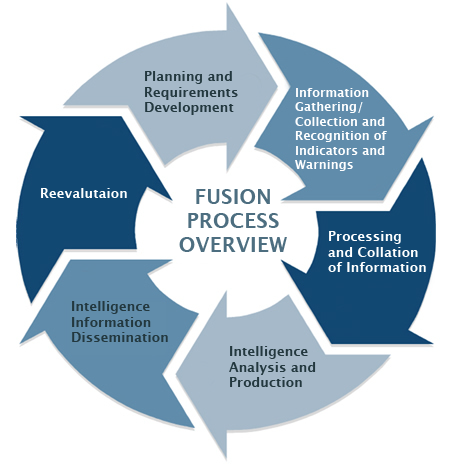National Network of State and Major Urban Area Fusion Centers
The ability to analyze and quickly draw appropriate inferences from multiple and sometimes disparate information sources lies at the heart of the challenge the ISE was established to address—to provide the right information to the right people in time to prevent terrorist attacks and to protect our communities and institutions.
Prior to 9/11, the information flow between Federal, state, local, tribal, and territorial partners was not sufficiently robust to achieve a strong, effective, and productive nationwide information sharing partnership. Today, thanks to ISE efforts, that is changing. Today, fusion centers serve as focal points within the state and local environment for the receipt, analysis, gathering, and sharing of threat-related information between the federal government and state, local, tribal, territorial (SLTT) and private sector partners. To support these information sharing efforts, federal agencies have made significant improvement in coordinating the planning and provision of deployed personnel, training, technical assistance, exercise support, security clearances, connectivity to federal systems, technology, and grant funding, in support of the National Network of Fusion Centers.
Fusion centers contribute to the Information Sharing Environment (ISE) through their role in receiving threat information from the Federal Government; analyzing that information in the context of their local environment; disseminating that information to local agencies; and gathering tips, leads, and suspicious activity reporting (SAR) from local agencies and the public. They are considered an ISE Core Capability and play important roles in almost all of the mission processes.
The concept of information fusion is not new; it builds upon the information-led policing concept that has been applied with great success for some time by law enforcement agencies across the country.
The figure below depicts the fusion process as a continuous cycle in which inputs from various sources—be they Federal, state, local, tribal, or territorial partners—are brought together to provide state and local context to help enhance the national threat picture. Using this process, those charged with protecting our communities are better informed, and our people and institutions will be better protected.

A number of activities are underway to support State and Major Urban Area Fusion Centers: 2010 Baseline Capabilities Assessment - Federal, state, and local officials launched the first nationwide, in-depth assessment of fusion centers to evaluate fusion center capabilities and to establish strategic priorities for Federal Government support. Visit the 2010 Baseline Capabilities Assessment page to learn more.
Enhancing Privacy, Civil Rights and Civil Liberties Protections
The National Network of Fusion Centers is currently working to finalize privacy policies for each of the recognized fusion centers. The goal is for all operational fusion centers to have policies determined to be “at least as comprehensive as” the ISE Privacy Guidelines by February 2011. Fact Sheet on Enhancing Fusion Center Privacy, Civil Rights, and Civil Liberties Protections.
Providing Access to Classified Information
A 2010 study of the current state of fusion center connectivity to federal Secret networks identified the need for consistent, sustainable processes to coordinate, manage, and oversee fusion center access to federal classified systems and information. As a follow-up, the PM-ISE is working with federal agencies operating Secret-level networks to coordinate information sharing policies and processes for the federal Secret-domain enterprise.
Building Communities of Trust
An initiative which focused on developing relationships of trust between police departments, fusion centers, and the communities they serve. The lessons learned from this initiative were synthesized to develop formal guidance (Guidance for Building Communities of Trust) for local police agencies, fusion centers and the local communities they serve, to emphasize the value of outreach and transparency and the importance of working with local police in becoming more sensitive to local community issues. In turn, local communities will be more willing to provide information on suspicious behaviors that could potentially help law enforcement agencies detect and prevent terrorist attacks. To learn more, a Building Communities of Trust Fact Sheet is also available.
Baseline Capabilities Assessment
In September 2010, federal, state, and local officials completed the first nationwide, in-depth assessment of fusion centers to evaluate fusion center capabilities and to establish strategic priorities for Federal Government support. Data collected during the Baseline Capabilities Assessment is being used to inform efforts by the Federal Government and fusion centers to strengthen fusion center capabilities, mitigate capability gaps, and develop and deploy federal resources.
This process will allow the Federal Government to evaluate opportunities to support the fusion centers' capacity to achieve the Baseline Capabilities for State and Major Urban Area Fusion Centers. Applying lessons learned from the Baseline Capabilities Assessment, the Federal Government will institute a repeatable assessment process to evaluate fusion center progress, identify and mitigate capability gaps in the National Network, and highlight opportunities for federal support to the National Network. Moving forward, the Federal Government will assist fusion centers in enhancing their capabilities in a manner that not only increases the efficacy and efficiency of individual fusion centers, but also supports an integrated National Network of Fusion Centers.












